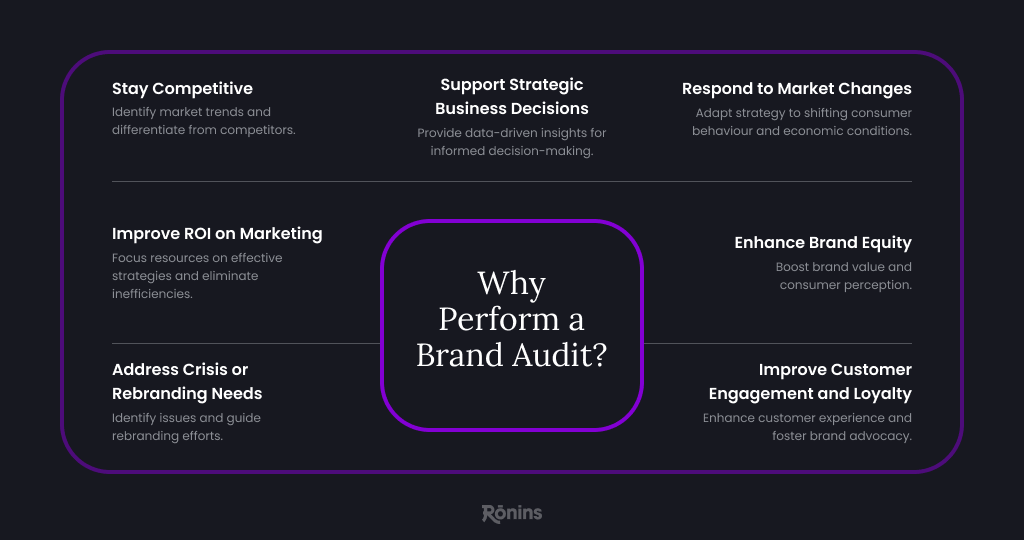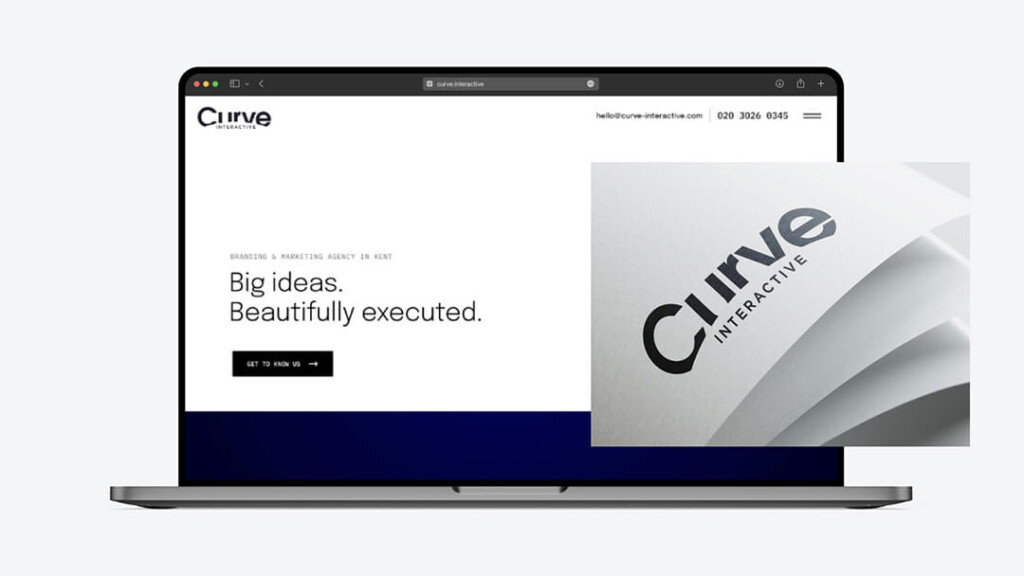
What is a brand audit? How to perform a brand check-up
Table of Contents
Key Takeaways
A brand audit is vital for evaluating your brand’s market position, identifying strengths and weaknesses, and aligning it with business goals.
It involves a detailed review of your brand’s identity, customer perception, and competitive landscape.
Regular audits help your brand stay relevant and competitive, providing actionable insights for continuous improvement and growth.
This article covers the essentials of a brand analysis, including its objectives, the benefits of conducting one, and the steps involved in effectively auditing your brand.

Brand Audits – Where Brand Strategies Are Born
Maintaining a relevant and strong brand identity is crucial in dynamic markets where brands constantly vie for consumer attention. But how do you ensure your brand resonates with your target audience and stands out from the competition?
Enter the brand audit—a comprehensive evaluation that delves into your brand’s performance, perception, and positioning. A brand audit isn’t just about fixing what’s broken; it’s about understanding how your brand compares to others, what’s working well and what could work even better.
• • •
What is a Brand Audit?
A brand audit report examines your brand’s current standing in the market compared to the competition and its relationship with your target audience. Think of it as a health check for your brand, where you assess everything from visual identity to audience perception, ensuring that your brand is aligned with your business goals and resonates with your audience.
Brand Audit Overview
A brand audit involves a detailed review and analysis of various aspects of your brand’s current position. This includes everything from your logo and marketing materials to your brand messaging, web analytics and customer interactions. The goal is to comprehensively understand how your brand is perceived internally and externally and how it measures up against competitors.
Components of a Brand Audit
A thorough brand audit report typically covers the following key components:
Brand Identity Analysis: This involves reviewing brand elements, including your logo, colour palette, typography, and other visual elements to ensure they effectively communicate your brand’s essence and appeal to your target market. It will identify whether a brand refresh or a completely new brand identity is required.
Brand Positioning and Messaging: Assess whether your brand’s positioning aligns with your business objectives and if your messaging clearly communicates your brand values and your unique value proposition.
Customer Perception and Experience: Gather insights into how people perceive your brand, satisfaction levels, and overall experience with your products or services.
Competitor Analysis: Competitive analysis to evaluate your brand’s performance, identifying areas where you excel and where you could improve.
Digital Presence and Performance: Examine your website, social media channels, and online content to assess their effectiveness and consistency with your brand strategy.
Why is a Brand Audit Important?
Understanding these components helps you to identify your brand’s strengths and weaknesses. By pinpointing areas that need improvement, you can develop strategies to enhance brand perception and effectiveness. This comprehensive understanding is crucial for maintaining a strong brand presence in an increasingly competitive marketplace.
A brand audit not only highlights areas of improvement but also confirms what is working well. This balanced view is essential for informed decision-making and strategic planning, ensuring your brand continues to meet the evolving needs of your audience.
• • •
Objectives of the Brand Audit Process
Conducting a brand audit is a strategic move to bolster your brand’s market presence and ensure it aligns with your business objectives. Here are the key objectives of a brand audit and why they’re essential for your brand’s health and growth.
Clarify Brand Position
One of the primary goals of a brand audit is to clarify where your brand’s market positioning. This involves a detailed analysis of your brand’s market position compared to competitors. Understanding your brand’s positioning helps in identifying gaps in the market that your brand can fill, thus carving out a unique space that resonates with your target audience.
Identify Weaknesses
A brand audit provides a clear, objective assessment of your brand’s strengths and weaknesses. This could be anything from outdated brand elements to a lack of clarity in messaging. Identifying these weaknesses is the first step towards rectifying them and ensuring your brand remains relevant and competitive.
Assess Brand Performance
Evaluating how well your brand is performing across various touchpoints is another critical objective. This includes reviewing customer engagement metrics, sales figures, and brand awareness levels. By assessing these areas, you can determine whether your brand is effectively reaching and engaging its audience.
Improve Brand Strategy
A brand audit offers valuable insights that can be used to refine and enhance your brand strategy. It helps you understand what aspects of your brand resonate with your audience and which ones need improvement. This informed approach enables you to develop a more focused and effective brand strategy that aligns with your business goals and market demands.
Enhance Customer Experience
Understanding how customers perceive your brand and interact with it is crucial. A brand audit allows you to gather feedback and identify areas where the customer experience can be improved. Enhancing the customer experience not only boosts customer satisfaction but also fosters loyalty and advocacy, which are critical for long-term brand success.
Support Marketing and Sales Goals
Aligning your brand efforts with broader marketing and sales goals is vital for business success. A brand audit ensures that your branding efforts are not only consistent but also supportive of your marketing and sales objectives. This alignment is crucial for creating cohesive campaigns that increase brand awareness and drive revenue growth.
Ensure Brand Consistency
Consistency is key in branding. A comprehensive brand audit ensures that all aspects of your brand, from brand voice and messaging to visual elements, are consistent across all platforms and channels. This consistency is crucial for building a strong, recognisable brand that resonates with your audience.
Align Internal Stakeholders to the Brand
A successful brand audit assesses external branding elements and ensures that internal stakeholders are aligned with your brand values and objectives. This involves examining how well the internal branding reflects your brand promise and voice and ensuring that everyone within the organisation understands and supports the brand’s overall business strategy. By aligning internal stakeholders, the brand exists cohesively across all touchpoints, which enhances the consistency and effectiveness of both internal and external branding efforts.
By setting these objectives, a successful brand audit serves as a roadmap for enhancing your brand’s market presence and ensuring its ongoing relevance and success.
• • •

Why Do a Brand Audit?
Maintaining a strong, relevant brand is more challenging than ever. Brand audits assist businesses in navigating the competitive landscape by providing a clear understanding of their brand’s current performance and identifying opportunities for growth and improvement. Here are some compelling reasons why conducting a brand audit is crucial for your business.
Stay Competitive
The business world is fiercely competitive, and brands must continuously evolve to stay relevant. A comprehensive brand audit helps you keep pace with market trends and consumer preferences. By assessing your brand’s strengths and weaknesses in comparison to competitors, you can identify areas where you can differentiate yourself and gain a competitive edge – vital for long-term success and market leadership.
Respond to Market Changes
Markets are constantly shifting, influenced by changes in technology, consumer behaviour, and economic conditions. A brand audit allows you to stay agile by highlighting how these changes affect your brand. It provides the actionable insights needed to adapt your brand strategy in response to these changes, ensuring that your brand remains relevant and continues to meet the needs of your target audience.
Improve ROI on Marketing
Marketing budgets are often stretched thin, and it’s essential to ensure that every pound spent is yielding the maximum return. A brand audit identifies which aspects of your brand and marketing initiatives are driving results and which are falling short. By focusing marketing strategies on what works and eliminating what doesn’t, you can improve the efficiency of your marketing spend and achieve a better return on investment.
Enhance Brand Equity
Brand equity refers to the value that your brand adds to your products or services, beyond the tangible benefits they offer. It’s built on the perceptions and experiences of your target customers. A brand audit helps you understand how your brand is perceived and where it stands in terms of equity. By identifying areas where you can improve, you can enhance your brand’s equity, making it more attractive to consumers and potentially allowing you to charge a premium for your products or services.
Address Crisis or Rebranding Needs
Brands can face crises that damage their reputation, or they may need to rebrand to stay relevant. A brand audit provides a thorough understanding of the current state of your brand, making it easier to identify and address issues that could be harming your brand’s image. It also lays the groundwork for a successful rebranding effort by pinpointing the aspects of your brand that need to change and those that should remain the same to retain brand loyalty and recognition.
Improve Customer Engagement and Loyalty
A successful brand audit provides insights into how customers perceive and interact with your brand. Understanding their experience helps you to identify ways to improve customer satisfaction and engagement. Enhancing these aspects boosts customer loyalty and turns target customers into brand advocates who are likely to recommend your brand to others, thereby aiding the sales process and driving organic growth.
Support Strategic Business Decisions
Effective decision-making requires accurate and up-to-date information. A brand audit provides comprehensive insights into your brand’s current state, supporting strategic decisions that align with your business goals. Whether you’re considering entering a new market, launching a new product, or adjusting your pricing strategy, a brand audit offers all the data and insights needed to make informed choices.
Conducting a brand audit is not just a task for times of trouble or transition; it’s a proactive measure that helps ensure your brand’s long-term health and success.
• • •
How to Conduct a Brand Audit
Conducting a strategic brand audit process requires careful planning and execution. It involves a series of steps designed to thoroughly assess your brand’s current state and identify areas for improvement. Here’s a step-by-step guide on how to carry out an effective brand audit.
Preparation
It’s crucial to lay a solid foundation before beginning the brand audit process. Preparation involves setting clear objectives and gathering the necessary resources.
Set Clear Objectives: Determine what you hope to achieve with your brand audit. Are you looking to improve brand perception, boost customer engagement, or enhance overall brand performance? Clear objectives will guide the audit process and ensure that your efforts are focused and effective.
Assemble Your Team: Gather a team of stakeholders, including marketing professionals, brand managers, and external consultants if needed. Ensure that everyone involved understands the goals and importance of the audit.
Gather Resources: Collect all relevant materials, such as brand guidelines, marketing materials, customer feedback, and sales data. These resources will be critical for a comprehensive assessment.
Data Collection
Data collection is the backbone of a brand audit. It involves gathering information from various sources to get a full picture of your brand’s performance.

Internal Data:
Brand Materials: Review all brand assets, including logos, slogans, websites, and social media marketing. Assess whether they align with your brand’s identity and message.
Employee Feedback: Gather insights from employees to understand internal perceptions of the brand. Employee feedback can provide valuable information on brand strengths and areas for improvement.
External Data:
Customer Surveys: Conduct customer surveys to gather customer opinions and perceptions of your brand and understand how customers view it compared to competitors.
Market Research: Analyse market trends and industry benchmarks to understand where your brand stands.
Competitor Analysis: Examine your competitors’ branding strategies, strengths and weaknesses to identify areas where your brand can differentiate itself.
Analysis
Once you have collected the data, the next step is to analyse it to uncover insights and identify opportunities for improvement.
Brand Identity Review: Assess whether your brand’s visual and messaging elements are consistent across all marketing efforts and effectively convey your brand’s identity. Check for alignment between your brand’s core values and how they are represented visually and verbally.
Market Analysis: Evaluate your brand’s position in the market relative to competitors. Identify trends that could impact your brand and potential gaps that your brand can fill.
Customer Insights: Analyse customer feedback and brand mentions to understand their perceptions, experiences and satisfaction levels. Identify common themes and areas where your brand excels or where the customer experience needs improvement.
Digital Audit: Review your digital presence, including your website analytics, social media presence and online content. Assess their performance, consistency, and effectiveness in conveying your brand message.

Evaluation
After analysing the data, it’s time to evaluate your findings to determine the overall health of your brand and identify specific areas for improvement.
Compare Performance Against Objectives: Measure your brand’s performance against the objectives set at the beginning of the audit. Identify any discrepancies and areas where your brand falls short.
SWOT Analysis: Conduct a SWOT analysis to identify your brand’s strengths, weaknesses, opportunities, and threats. This framework will help you understand where your brand excels and where it needs improvement.
Reporting
Compile your findings into a comprehensive report that provides a clear overview of your brand’s current state and actionable recommendations for improvement.
Summary of Findings: Summarise the key insights from your data analysis, highlighting the most critical areas for attention.
Recommendations: Provide specific, actionable recommendations for improving your brand’s performance. Prioritise these actions based on their potential impact and feasibility.

Develop an Action Plan
Develop a detailed action plan to address the identified issues and implement improvements based on your report.
Set Priorities: Identify which recommendations should be tackled first based on their importance and urgency.
Develop Timelines: Create a timeline for implementing each recommendation, ensuring your action plan is realistic and achievable.
Assign Responsibilities: Allocate tasks to specific team members, ensuring everyone knows their role in the implementation process.
Review and Monitor
A brand audit is not a one-time task but an ongoing process. Regular reviews and monitoring are essential to ensure your brand continues evolving and staying relevant.
Establish Metrics: Define key performance indicators (KPIs) to measure the success of your brand improvements. These metrics will help you track progress and make data-driven decisions.
Conduct Regular Audits: Schedule regular brand audits to align your brand with your business goals and market conditions. Continuous monitoring helps you stay ahead of changes and adapt your strategy as needed.
By following these steps, you can conduct a brand assessment that provides comprehensive, valuable insights and paves the way for a stronger, more effective brand strategy. This proactive approach ensures that your brand remains competitive and continues to resonate with your target audience.
With this structured approach, your brand audit will yield meaningful insights, helping you to refine your brand strategy and maintain a strong market presence.
Brand Audit Checklist
Brand audits can be a detailed and sometimes daunting process, but having a structured approach can simplify the task and ensure you cover all critical aspects. To help you conduct a brand audit and stay organised, we’ve created a comprehensive brand audit checklist.
This brand audit framework is a step-by-step guide, ensuring you don’t miss any vital elements and providing a clear framework for your audit.
Ensuring a Successful Brand Audit
A comprehensive and objective understanding of your brand, both internally and externally, is essential for building a robust and relevant brand and maintaining a competitive advantage. The brand audit process should be revisited regularly to maintain your brand’s effectiveness and relevance. It can take a week to several months, but the result is a clear, actionable plan for your brand’s future growth and development.





